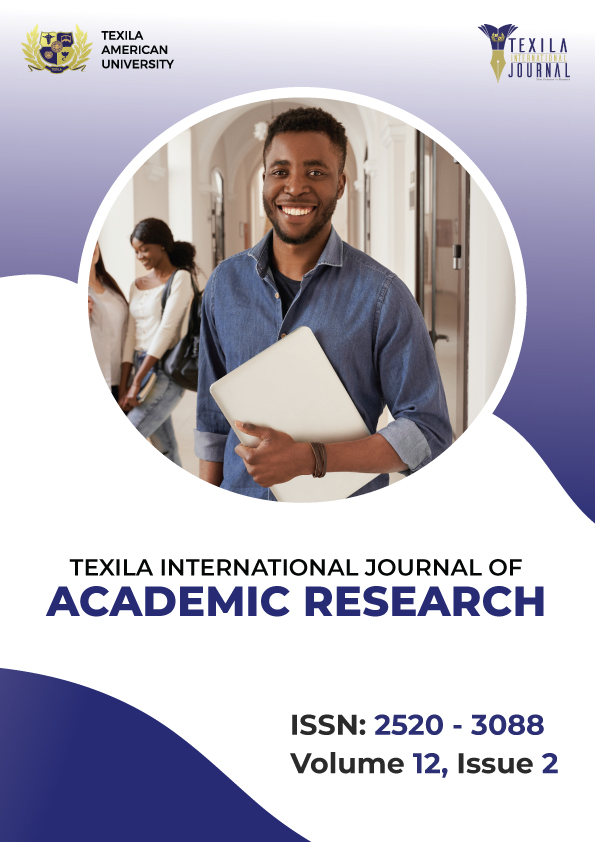References:
[1]. Ota, M.
O. C., Badur, S., Romano-Mazzotti, L., Friedland, L. R., 2022, Impact of
COVID-19 on routine immunization in LMICs. Lancet Infectious Diseases.,
22(1), e26-e33, https://doi.org/10.1016/S1473-3099(21)00490-3.
[2]. Mahachi,
K., Muñiz, M., Jarrett, P., Dube, F., Suchdev, P. S., Brenner, J. L., 2022,
Sustained reductions in missed opportunities for vaccination in Africa. Bulletin
of the World Health Organization., 100(1), 54-61, https://doi.org/10.2471/BLT.21.286644.
[3]. World
Health Organization., 2016, Global routine immunization strategies and
practices. WHO Press., 1(1), 1-100, https://www.who.int/publications.
[4]. Cata-Preta,
B. O., Santos, T. M., Mengistu, T., Hogan, D. R., Barros, A. J. D., Victora, C.
G., 2021, Zero-dose children and the immunisation cascade: Understanding
immunisation pathways in low- and middle-income countries. Vaccine.,
39(32), 4564-4570, https://doi.org/10.1016/j.vaccine.2021.02.072
[5]. Adebimpe,
W. O., Adeoye, O. A., 2021, Routine immunization coverage in Nigeria: A
systematic review and meta-analysis. Vaccine., 39(15), 2181-2191, https://doi.org/10.1016/j.vaccine.2021.02.053.
[6]. Sato,
R., 2023, Global inequality in immunization coverage among the poorest
children. Vaccine., 41(12), 1986-1992, https://doi.org/10.1016/j.vaccine.2023.02.014.
[7]. United
States Agency for International Development (USAID)., 2009, Nigeria: Child
survival and health. USAID/Nigeria., 1(1), 1-50, https://www.usaid.gov/nigeria.
[8]. National
Population Commission (NPC) [Nigeria]., 2013, Nigeria demographic and health
survey 2008. NPC and ICF International., 1(1), 1-300, https://dhsprogram.com/publications.
[9]. Adebayo,
S. B., Olukoshi, A., Adeyemi, O. S., 2012, Understanding the drivers of
immunization inequality in Nigeria. African Journal of Medicine and Medical
Sciences., 41(4), 479-491, https://www.ajol.info/index.php/ajmms.
[10]. Odusanya,
O. O., Alufohai, E. F., Meurice, F. P., Ahonkhai, V. I., 2008, Determinants of
vaccination coverage in rural Nigeria. BMC Public Health., 8(1),
381, https://doi.org/10.1186/1471-2458-8-381.
[11]. Danovaro-Holliday,
M. C., Dansereau, E., Rhoda, D. A., Brown, D. W., Cutts, F. T., Gacic-Dobo, M.,
2021, Zero-dose children and the immunisation cascade: Understanding
immunisation pathways in low- and middle-income countries. Vaccine.,
39(32), 4564-4570, https://doi.org/10.1016/j.vaccine.2021.02.072.
[12]. Mosser,
J. F., Gagne-Maynard, W., Rao, P. C., Osgood-Zimmerman, A., Fullman, N.,
Graetz, N., et al., 2019, Mapping diphtheria-pertussis-tetanus vaccine coverage
in Africa, 2000–2016: A spatial and temporal modelling study. Lancet.,
393(10183), 1843-1855, https://doi.org/10.1016/S0140-6736(19)30226-0.
[13]. Abdulraheem,
I. S., Olapipo, A. R., Amodu, M. O., 2011, Primary health care services in
Nigeria: Critical issues and strategies for enhancing the use by the rural
communities. Journal of Public Health and Epidemiology., 4(1),
5-13, https://academicjournals.org/journal/JPHE.
[14]. Wendt,
A., Santos, T. M., Cata-Preta, B. O., Hogan, D. R., Mengistu, T., Arroyave, L.,
et al., 2022, Children of more empowered women are less likely to be left
without vaccination in low- and middle-income countries: A global analysis of
50 DHS surveys. Journal of Global Health., 12, 04022, https://doi.org/10.7189/jogh.12.04022.
[15]. Fagbamigbe,
A. F., Oyinlola, F. F., Adebowale, A. S., 2020, Survival analysis and
prognostic factors of time to first vaccination in Nigeria: A multilevel
analysis. PLOS ONE., 15(6), e0234918, https://doi.org/10.1371/journal.pone.0234918.
[16]. Gostin,
L. O., Hodge, J. G., Bloom, B. R., El-Mohandes, A., Fielding, J., Hotez, P., et
al., 2020, The public health crisis of underimmunisation: A global plan of
action. Lancet Infectious Diseases., 20(1), e11-e16, https://doi.org/10.1016/S1473-3099(19)30558-4.
[17]. Lindstrand,
A., Cherian, T., Chang-Blanc, D., Feikin, D., O’Brien, K. L., 2021, The world
of immunization: Achievements, challenges, and strategic vision for the next
decade. Journal of Infectious Diseases., 224(Suppl 4), S452-S467, https://doi.org/10.1093/infdis/jiab284.
[18]. District
Health Information System 2 (DHIS2)., 2024, Immunization data for Ifelodun LGA,
Kwara State [unpublished internal report]., 1(1), 1-20, https://www.dhis2.org.
[19]. National
Population Commission (NPC) [Nigeria], ICF., 2019, Nigeria Demographic and
Health Survey 2018. NPC and ICF., 1(1), 1-400, https://dhsprogram.com/publications.
[20]. Abdulraheem,
I. S., Onajole, A. T., Jimoh, A. A. G., Oladipo, A. R., 2011, Reasons for
incomplete vaccination and factors for missed opportunities among rural
Nigerian children. Journal of Public Health and Epidemiology., 3(4), 194-203, https://academicjournals.org/journal/JPHE.
[21]. Fagbamigbe,
A. F., Oyinlola, F. F., Adebowale, A. S., 2020, Patterns and determinants of
dropout from childhood immunization in Nigeria. BMC Public Health.,
20(1), 1-12, https://doi.org/10.1186/s12889-020-09350-9.
[22]. Mohammed,
H., Atomsa, A., Lami, M., 2019, Immunization dropout rate and associated
factors among children in Ethiopia: Systematic review and meta-analysis.
PLOS ONE., 14(6), e0218511, https://doi.org/10.1371/journal.pone.0218511.
[23]. Singh,
P. K., Yadav, R. J., Pandey, A., 2020, Institutional delivery and childhood
immunization in India: A district-level analysis. PLOS ONE., 15(4),
e0230669, https://doi.org/10.1371/journal.pone.0230669.
[24]. Maina,
L. C., Karanja, S., Kombich, J., 2020, Immunization dropouts among infants in
Kenya: A spatial analysis. BMC Health Services Research., 20(1),
1-10, https://doi.org/10.1186/s12913-020-05564-2.
[25]. Khan,
M. U., Ahmad, A., Aqeel, T., Salman, S., Idrees, M., 2018, Factors associated
with partial and non-immunization in Pakistani children. Journal of
Epidemiology and Global Health., 8(1-2), 55-62, https://doi.org/10.2991/j.jegh.2018.08.103.
[26]. Sato,
R., 2022, Effect of mobile phone reminders on childhood immunization in Uganda:
A randomized controlled trial. Vaccine., 40(10), 1445-1452, https://doi.org/10.1016/j.vaccine.2021.12.068.
[27]. Mugabo,
P., Rujumba, J., Ntawukuriryayo, J. T., Nkurunziza, T., 2021, Dropout from
childhood vaccination in the Democratic Republic of Congo: A cross-sectional
study in Kinshasa. Vaccine., 39(8), 1243-1250, https://doi.org/10.1016/j.vaccine.2020.12.065.
[28]. Hussain,
S. F., Boyle, P., Patel, P., Sullivan, R., 2020, Community health workers
improve vaccination completion in Bangladesh: A cluster-randomized trial. Vaccine.,
38(15), 3089-3095, https://doi.org/10.1016/j.vaccine.2020.02.074.
[29]. Babalola,
S., 2021, Factors associated with incomplete immunization among children in
Nigeria: A systematic review. BMC Public Health., 21(1), 1453, https://doi.org/10.1186/s12889-021-11498-x.
[30]. Adebowale,
A. S., 2020, Determinants of pentavalent vaccine dropout in rural Nigerian
communities: A mixed-methods study. Vaccine., 38(45), 7128-7135, https://doi.org/10.1016/j.vaccine.2020.09.026.
[31]. National
Primary Health Care Development Agency (NPHCDA)., 2022, National Routine
Immunization Strategic Plan 2021-2025. NPHCDA., 1(1), 1-85, https://www.nphcda.gov.ng/publications.
[32]. Okoli,
C., 2019, Barriers to complete childhood immunization in sub-Saharan Africa:
Evidence from Nigeria and Kenya. PLOS ONE., 14(6), e0217968, https://doi.org/10.1371/journal.pone.0217968.
[33]. Larson,
H. J., Jarrett, C., Eckersberger, E., Smith, D. M. D., Paterson, P., 2015,
Understanding vaccine hesitancy around vaccines and vaccination from a global
perspective: A systematic review of published literature, 2007–2012. Vaccine.,
32(19), 2150-2159, https://doi.org/10.1016/j.vaccine.2014.01.081.
[34]. Babalola,
S., 2011, Maternal reasons for non-immunisation and partial immunisation in
northern Nigeria. Journal of Paediatrics and Child Health., 47(5),
276-281, https://doi.org/10.1111/j.1440-1754.2010.01956.x.
[35]. Amponsah‐Achiano,
K., Oduro, A. R., Mensah, A. K., Nuro‐Ameyaw, P., 2019, Factors influencing
childhood immunization in Ghana: A qualitative study. BMC Public Health.,
19(1), 1-10, https://doi.org/10.1186/s12889-019-7549-8.
[36]. Wiyeh,
A. B., Cooper, S., Jaca, A., Mavundza, E., Ndwandwe, D., Wiysonge, C. S., 2020,
Vaccine stockouts in Africa: A systematic review. Human Vaccines &
Immunotherapeutics., 16(4), 851-857, sshttps://doi.org/10.1080/21645515.2019.1670039.
[37]. Sheikh,
A., Iqbal, B., Ebrahim, G. J., Southall, D. P., 2020, Zero-dose children in
India: Who are they and why are they unvaccinated?. Vaccine., 38(7),
1706-1714, https://doi.org/10.1016/j.vaccine.2019.12.021.
[38]. Banda,
C., Sheppard, P., Masaninga, F., Chizema, E., 2022, Predictors of immunization
dropouts in Zambia: A multilevel analysis. Vaccine., 40(12), 1834-1841, https://doi.org/10.1016/j.vaccine.2022.01.050.
[39]. Were,
F., Kariuki, D., Chepkwony, R., 2021, Sources of immunization information and
their influence on childhood vaccination in Kenya. BMC Public Health.,
21(1), 1-9, https://doi.org/10.1186/s12889-021-10450-3.


